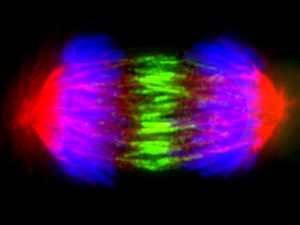The Research Connection – August 2020: Cancer Research Edition

Featured R&D projects:
-
Transfer RNAs in Cancer
Improving Targeted Therapies against Solid Tumors
Targeting the Chaperone of Kidney Cancer
Choice of anesthesia may affect breast metastases
New inhibitor shows promise against metastatic prostate cancer
A Tumor Model that More Closely Mimics the Body
Protein Linked to Cancer Acts as a Viscous Glue in Cell Division
Innovative Real-Time Imaging of Cancer Cell Behavior
This edition’s contributors: SUNY Research Foundation | SUNY Polytechnic Institute | University at Buffalo | Stony Brook University | Upstate Medical University | Rensselaer Polytechnic Institute
Transfer RNAs in Cancer
 Cancer develops because the information pathways within cells cease to function normally. Ribonucleic acids, or RNAs, act at almost every cellular information processing level to ensure healthy cell function. New in cancer biology is the idea that a class of RNAs known as transfer RNAs (tRNAs) can drive otherwise healthy cells to form cancer by altering their chemical modification patterns. SUNY Polytechnic Institute biologist Lauren Endres examines the effects of stress exposure on different tRNA chemistries, with implications for bladder and ovarian cancer development. Understanding how tRNA chemistries alter during cancer development may open new avenues for the development of anti-cancer drugs. Endres’ research involves collaborative partnerships with SUNY Poly’s College of Nanoscale and Engineering and The RNA Institute at the University at Albany and is open to new connections. Collaborate with the research team.
Cancer develops because the information pathways within cells cease to function normally. Ribonucleic acids, or RNAs, act at almost every cellular information processing level to ensure healthy cell function. New in cancer biology is the idea that a class of RNAs known as transfer RNAs (tRNAs) can drive otherwise healthy cells to form cancer by altering their chemical modification patterns. SUNY Polytechnic Institute biologist Lauren Endres examines the effects of stress exposure on different tRNA chemistries, with implications for bladder and ovarian cancer development. Understanding how tRNA chemistries alter during cancer development may open new avenues for the development of anti-cancer drugs. Endres’ research involves collaborative partnerships with SUNY Poly’s College of Nanoscale and Engineering and The RNA Institute at the University at Albany and is open to new connections. Collaborate with the research team.
Potential applications: Development of anti-cancer drugs.
Contact: Lauren Endres, Assistant Professor, Biology, endresl@sunypoly.edu
Image citation: tRNA modification and cancer: potential for therapeutic prevention and intervention, Endres, Lauren ; Fasullo, Michael ; Rose, Rebecca, Future Medicinal Chemistry, 2019-02-01, Vol.11 (8), p.885-900.
Improving Targeted Therapies against Solid Tumors
 Anticancer antibodies demonstrate limited distribution in solid tumors due to the cancer’s pathophysiologic characteristics, some of which include chaotic cellular growth, dense extracellular matrices and disorganized blood vessels. Research led by University at Buffalo professor Joseph Balthasar aims to test three platform strategies designed to enhance the distribution of anticancer antibodies and antibody conjugates within solid tumors. Collaborate with the research team.
Anticancer antibodies demonstrate limited distribution in solid tumors due to the cancer’s pathophysiologic characteristics, some of which include chaotic cellular growth, dense extracellular matrices and disorganized blood vessels. Research led by University at Buffalo professor Joseph Balthasar aims to test three platform strategies designed to enhance the distribution of anticancer antibodies and antibody conjugates within solid tumors. Collaborate with the research team.
Potential Applications: New agents developed in this project may be used to improve the efficacy of antibodies for treatment of all cancers that arise as solid tumors, including breast, lung, colorectal and prostate cancers.
Contact: Joseph Balthasar, Assistant Professor, Biology, jb@buffalo.edu
Targeting the Chaperone of Kidney Cancer
 Upstate Medical University urology professor Mehdi Mollapour, PhD, has led a decade-long research project into understanding kidney cancer biology and to develop novel therapeutic strategies to treat patients. Mollapour’s laboratory, which is funded by several grants from the National Institutes of Health, National Cancer Institute and the Department of Defense, identified a prosurvival role for PP5 protein in kidney cancer. Collaborate with the research team.
Upstate Medical University urology professor Mehdi Mollapour, PhD, has led a decade-long research project into understanding kidney cancer biology and to develop novel therapeutic strategies to treat patients. Mollapour’s laboratory, which is funded by several grants from the National Institutes of Health, National Cancer Institute and the Department of Defense, identified a prosurvival role for PP5 protein in kidney cancer. Collaborate with the research team.
Potential applications: Kidney cancer therapeutic.
Contact: Mehdi, Mollapour, Vice Chair for Translational Research, Urology Department, mollapom@upstate.edu
Choice of anesthesia may affect breast metastases
 A new study led by Stony Brook University Cancer Center researchers suggests that the choice of anesthesia may change the metastatic process of breast cancer by affecting the cytokine and microenvironment. The findings may serve as a guide to design clinical trials for clinicians to optimize anesthesia choice for breast cancer surgery in order to achieve best long-term outcomes. Collaborate with the research team.
A new study led by Stony Brook University Cancer Center researchers suggests that the choice of anesthesia may change the metastatic process of breast cancer by affecting the cytokine and microenvironment. The findings may serve as a guide to design clinical trials for clinicians to optimize anesthesia choice for breast cancer surgery in order to achieve best long-term outcomes. Collaborate with the research team.
Potential applications: Breast cancer treatment.
Contact: Jun Lin, Professor of Anesthesiology, Renaissance School of Medicine, Jun.Lin@StonyBrookMedicine.edu
New inhibitor shows promise against metastatic prostate cancer
 Taxanes are used to treat metastatic prostate cancer. While they can be effective, tumors often build up resistance to these drugs. Patients also often experience adverse effects to these drugs. A Stony Brook University-led research team believes a new approach that inhibits a specific fatty acid binding protein (FABP) could be a potential solution to treating advanced disease more effectively and minimize adverse effects. Collaborate with the research team.
Taxanes are used to treat metastatic prostate cancer. While they can be effective, tumors often build up resistance to these drugs. Patients also often experience adverse effects to these drugs. A Stony Brook University-led research team believes a new approach that inhibits a specific fatty acid binding protein (FABP) could be a potential solution to treating advanced disease more effectively and minimize adverse effects. Collaborate with the research team.
Potential applications: Prostate cancer therapeutic.
Contact: Iwao Ojima, Director, Institute of Chemical Biology and Drug Discovery | iwao.ojima@stonybrook.edu
A Tumor Model that More Closely Mimics the Body
 There is a growing appreciation for the ways in which the biomechanics of the tumor environment may contribute to how its cells grow and even spread throughout the body. The more closely researchers can reproduce those mechanical factors in the lab, the better they will understand tumor cell migration and how to stop cells before they invade other tissue. A team of mechanical engineers at Rensselaer Polytechnic Institute recently demonstrated a new technique for creating a model for studying tumors that is more complex and, therefore, closer to what cancer cells may encounter in the body.
There is a growing appreciation for the ways in which the biomechanics of the tumor environment may contribute to how its cells grow and even spread throughout the body. The more closely researchers can reproduce those mechanical factors in the lab, the better they will understand tumor cell migration and how to stop cells before they invade other tissue. A team of mechanical engineers at Rensselaer Polytechnic Institute recently demonstrated a new technique for creating a model for studying tumors that is more complex and, therefore, closer to what cancer cells may encounter in the body.
Potential Applications: Advancing tumor cell research, enabling the discovery of effective therapeutics
Contact: Torie Wells, buckv@rpi.edu
Protein Linked to Cancer Acts as a Viscous Glue in Cell Division
 Research into the mechanics of cell division shows that a protein linked to many cancer types – including prostate, ovarian, and breast cancer – acts as a “viscous glue” during cell division. The protein, PRC1, helps to precisely control the speed at which two sets of DNA are separated as a single cell divides. The finding could explain why too much or too little PRC1 disrupts that process and causes genome errors linked to cancer.
Research into the mechanics of cell division shows that a protein linked to many cancer types – including prostate, ovarian, and breast cancer – acts as a “viscous glue” during cell division. The protein, PRC1, helps to precisely control the speed at which two sets of DNA are separated as a single cell divides. The finding could explain why too much or too little PRC1 disrupts that process and causes genome errors linked to cancer.
Potential Applications: Drug discovery, cancer therapies, genetic therapies
Contact: Mary Martialay, martim12@rpi.edu
Innovative Real-Time Imaging of Cancer Cell Behavior
 In order to effectively address intractable challenges in oncology, researchers, drug developers, and clinicians need to be able to see how a potential therapeutic interacts with cells in a living system, ideally in real time. A $2.5 million grant from the National Institutes of Health’s National Cancer Institute (NCI) will support the further development of a new imaging technique, pioneered by Rensselaer biomedical engineering professor Xavier Intes, that will allow cancer biologists to observe the molecular, metabolic, and functional behavior of breast cancer cells when interacting with a targeted therapeutic, specifically trastuzumab, in preclinical models.
In order to effectively address intractable challenges in oncology, researchers, drug developers, and clinicians need to be able to see how a potential therapeutic interacts with cells in a living system, ideally in real time. A $2.5 million grant from the National Institutes of Health’s National Cancer Institute (NCI) will support the further development of a new imaging technique, pioneered by Rensselaer biomedical engineering professor Xavier Intes, that will allow cancer biologists to observe the molecular, metabolic, and functional behavior of breast cancer cells when interacting with a targeted therapeutic, specifically trastuzumab, in preclinical models.
Potential Applications: Image-guided drug delivery, enabling precision and personalized medicine, improving development of new therapeutics
Contact: Torie Wells, buckv@rpi.edu
About The Research Connection: The Research Connection is a quarterly feature in the Center for Economic Growth’s monthly, online newsletter, The CEG Indicator. This special feature highlights R&D being conducted by researchers at Capital Region colleges and universities and others throughout the SUNY system. The Research Connection spotlights academic R&D in CEG’s focus technology sectors: Nanotechnology and Semiconductors, Cleantech/Energy, Biotechnology, Advanced Materials, Population Health Technology and Information Technology.
Each edition of The Research Connection will highlight several research projects in a specific technology sector. The Research Connection will keep CEG investors (2,500+) and CEG Indicator subscribers (9,000+) informed on the cutting-edge R&D that is being conducted by SUNY and other academic researchers that could potentially transform their industries. It will also encourage collaboration, patent, licensing and other opportunities.
Don’t miss these insights into the trends that are shaping the Capital Region’s economy. Sign up for CEG’s e-news and follow us on:














